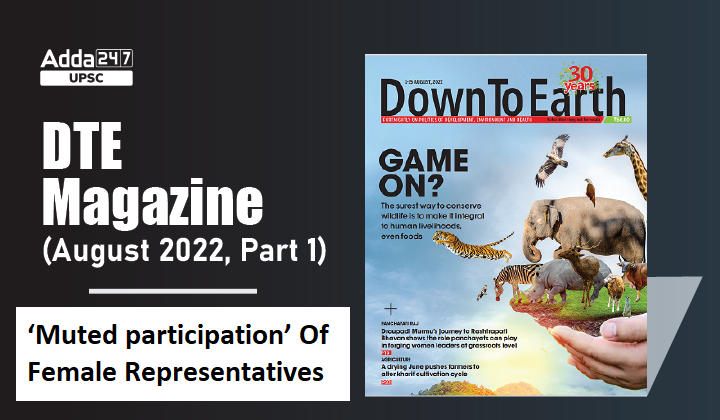Table of Contents
Down To Earth Magazine is a fortnightly magazine focusing on politics of environment and development, published in New Delhi, India.
UPSC Previous years’ questions on Development, Environment, Health and Disaster Management give us a clear idea about the increased importance of Down To Earth Magazine.
Down To Earth Magazine is one of the most important and indispensable source for UPSC Civil Services Exam Preparation. Keeping this in mind, here, we come with ”Gist Of Down To Earth Magazine” which covers important environmental current affairs articles in smooth pointed form, keeping in mind the demand of UPSC aspirants.
Introduction
- In the 30th year of Panchayati raj, India got its first woman president from the Adivasi community.
- But the rise of Droupadi Murmu from the position of a Nagar panchayat councillor in Odisha to the Rashtrapati Bhavan does not tell the real story of women’s leadership in India’s Panchayati raj institutions (PRIs).
Current Status Of Female Representatives in 3 Tiers Of Government
- India has 1.45 million female elected representatives in PRIs, the highest in the world.
- This impressive representation at the grassroot level of governance does not percolate to other levels of governance. In the current Parliament, the Rajya Sabha has only 12.24 per cent of women representatives.
- In the Lok Sabha, the representation is nominally better at 14.44 per cent.
- Women make up an even smaller proportion of state legislative assemblies, accounting for an average of only 8 per cent of all elected members. While Nagaland and Mizoram do not have a single female member in their legislative assemblies, another 15 states/UTs have less than 8 per cent women representation.
How much do we gain from decentralisation?
- While the 73rd Constitutional Amendment of 1992 says at least one-third of the PRIs seats must be re-served for women, over 15 states have extended women’s reservation to 50 per cent. The reservation is implemented through rotation to ensure all constituencies are covered.
- The process of decentralisation has provided representation, but representation does not necessarily lead to participation. It alone is not sufficient for women to exercise their roles.
- However, many women began their careers in PRIs before moving on to legislative assemblies or Parliament, but still, only a handful of them reach state and national levels.
The practice of proxy candidature in PRIs
- The practice of proxy candidature exists across the country, though the degree differs from state to state.
- Proxy candidature is more common in northern states, particularly Bihar, Haryana, and Rajasthan, than in southern states such as Tamil Nadu and Kerala.
Mani Shankar Aiyar Formula!
- India’s first Union panchyati raj minister in 2004, offers a different way of increasing women’s participation.
- According to him, in the next two-three years, the number of Lok Sabha seats will go from 540 to over 800. The entire increased number of seats should be reserved for women.
- This way, without a man being disqualified because of his gender, women will be absorbed into Parliament in large numbers. The same route can be applied to state assemblies.
What is the Status Of Reservation in Parliament?
- Given the situation, the women politicians demand reservations in Parliament and state assemblies. But the intent seems to be the problem.
- In May 2008, the Rajya Sabha introduced a Bill to reserve 33 per cent of the seats in Parliament and state assemblies for women. The Upper House passed the Bill in 2010 and transferred it to the Lok Sabha, where it eventually lapsed in 2014 without a proper discussion.
Kerala’s Kudumbashree scheme!
- Kerala’s Kudumbashree scheme offers some insights into how to increase women’s participation.
- Launched for poverty alleviation in 1998, the scheme consists of a three-tier structure with neighbourhood groups as primary level units, area development societies at the ward level, and community development societies at the local government level.
- Membership is open to all adult women and limited to a single membership per household.
- The neighbourhood groups, consisting of around 20 members, work on a range of issues such as health, nutrition, and agriculture, besides carrying out income generation activities and seeking microcredit.
- Most women elected to PRIs in Kerala have evolved from the Kudumbashree network.
What needs to be done?
India needs to reform Panchayati raj institutions, and reserve seats in Parliament and legislative assemblies to create more women leaders like the new President Droupadi Murmu



 TSPSC Group 1 Question Paper 2024, Downl...
TSPSC Group 1 Question Paper 2024, Downl...
 TSPSC Group 1 Answer key 2024 Out, Downl...
TSPSC Group 1 Answer key 2024 Out, Downl...
 UPSC Prelims 2024 Question Paper, Downlo...
UPSC Prelims 2024 Question Paper, Downlo...
